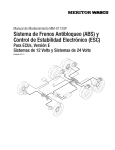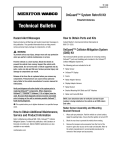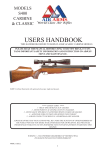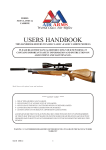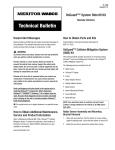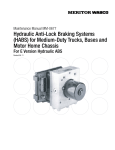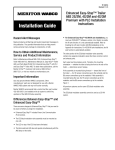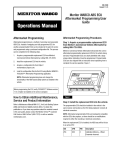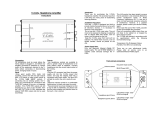Download TP1388 - Meritor WABCO
Transcript
TP-1388 Issued 09-13 Technical Bulletin Electronically Controlled Air Suspension (ECAS) Retrofit Kit Installation Instructions for Meritor WABCO 6S/6M ATC Brake Systems Issued 1TP-1388 Technical 09-13 Bulletin Hazard Alert Messages ECAS Overview Read and observe all Warning and Caution hazard alert messages in this publication. They provide information that can help prevent serious personal injury, damage to components, or both. The Meritor WABCO ECAS is an electrically controlled air suspension system designed to enhance the performance of the vehicle’s air suspension when equipped with a Meritor WABCO 6S/6M ATC brake system. The ECAS maintains an accurate leveling of the chassis height through the use of height sensors, electronic control unit (ECU) and solenoid valves. Because of the variety of suspension types and vehicle features, a particular set of parameters was developed for each vehicle type. These parameters determine some of the features and characteristics for the ECAS configuration. In the event of a malfunction in the system, the ECAS indicator lamp will alert the driver and the suspension will retain the existing air pressure in the air suspension bellows. Several of the features provided by ECAS include the following. WARNING To prevent serious eye injury, always wear safe eye protection when you perform vehicle maintenance or service. Park the vehicle on a level surface. Block the wheels to prevent the vehicle from moving. Support the vehicle with safety stands. Do not work under a vehicle supported only by jacks. Jacks can slip and fall over. Serious personal injury and damage to components can result. Release all air from the air systems before you remove any components. Pressurized air can cause serious personal injury. Refer to the vehicle manufacturer’s service manual for instructions. How to Obtain Additional Maintenance, Service and Product Information Refer to Maintenance Manual MM-1315, Electronically Controlled Air Suspension (ECAS) for Buses and Trucks with CAN II (SAE 1939); and User Guide SP-1372, Electronically Controlled Air Suspension (ECAS) Driver Tips. If you have any questions about the material covered in this publication, or for more information about the Meritor WABCO product line, please contact the OnTrac Customer Service Center at 866-OnTrac1 (668-7221) or visit our website: meritorwabco.com How to Obtain Parts and Kits Contact Meritor’s Commercial Vehicle Aftermarket at 888-725-9355. TOOLBOX™ Software This procedure requires TOOLBOX™ Software version 11.0 or higher. To download this software, visit meritorwabco.com. 앫 Automatic Level Control — The ECAS continually monitors the vehicle’s height (axle-to-frame distances) through the ECU and the use of height and pressure sensors. When the height deviates from the preset nominal level, a correction is made quickly, exhausting or pressurizing the air suspension bellows by actuating solenoid valves. The ECAS will maintain the nominal vehicle level regardless of the number of passengers boarding or unloading. There are pre-selected restrictions for when the height corrections can be made. 앫 Driver-Controlled Level Adjustment — Other than the nominal vehicle level, there can be additional levels selected by the driver to raise the vehicle for rough surfaces or lower vehicle height. These levels can be selected by switches on the vehicle dash panel. The driver can also return the vehicle to the nominal level (Recovery). There are pre-selected restrictions for when the height changes can be made. 앫 Automatic Traction Help Load Transfer — When wheel slippage is detected by the vehicle’s ABS (due to slippery road surface conditions), a signal from the ABS triggers the ECAS system. The ECAS can transfer weight from the non-drive axle (tag) to the vehicle’s drive axle by changing air pressures in the rear axles air suspension bellows. By transferring pressure from the tag axle to the drive axle air bellows, additional weight is transferred to the drive axle, increasing drive wheel traction. This function may also be initiated by the driver activating a switch on the vehicle dash panel. There are pre-selected restrictions for when the traction help can be activated and how much weight can be transferred. The ECAS will continue to hold the transferred load until the preset speed limit has been met, which is 25 mph. If the load transfer is active, all chassis height control functions are suspended until the load transfer has ended. Figure 1 4010354a ECAS ECU Figure 1 Figure 2 앫 Inclination Level Control (Pressure Equality) — The ECAS ECU can adjust pressures in all air suspension bellows together or in individual air bellows. This allows the ECAS to compensate for inclinations caused by unbalanced loads or uneven road surfaces. Kit Parts List Locate and verify that the kit is complete and that you have access to TOOLBOX™ Software version 11.0 or higher prior to beginning the installation of this kit. Table A: Kit Parts Description Part Number Quantity ECAS ECU S400 850 920 0 1 ECAS Cab Harness S400 850 916 0 1 ECAS Frame Harness S400 850 918 0 1 ECAS Solenoid Valves S472 880 073 0 2 Distance Sensor S441 050 100 0 1 ECAS Sensor Lever S441 050 718 2 1 ECAS Sensor Linkage S433 401 003 0 1 Pressure Sensors S441 044 106 0 2 M22 Fitting Adapters 1/2” S400 851 002 4 6 ECAS Valve Bracket S400 850 055 4 2 4010357a ECAS SOLENOID VALVES Figure 2 Figure 3 4010363a DISTANCE SENSOR Figure 3 TP-1388 Issued 09-13 Page 2 Copyright Meritor, Inc., 2013 (16579) Printed in USA Figure 4 Figure 7 4010860a 4010898a PRESSURE SENSOR Figure 4 ECAS CAB HARNESS Figure 7 Figure 5 Table B: Additional Items Required 4010861a M22 FITTING ADAPTERS 1/2” Figure 5 Description Quantity Various quick connect fittings for the air lines As needed Street T Fittings (1/4″) 2 Valve Mounting Nuts (5/16″) 4 Valve Mounting Bolts (2-1/2-inch, 5/16″) 4 Bracket Mounting Nuts (5/8″) 4 Bracket Mounting Bolts (2-inch, 5/8″) 4 Additional Air Line As needed Incandescent Amber Light – DO NOT USE LED Lights 1 Incandescent Red Light – DO NOT USE LED Lights 1 Three-Position Momentary Switch 1 Two-Position Momentary Switch 1 J1939 Y Connector 1 J1939 Connectors 3 Figure 6 4010895a ECAS FRAME HARNESS Figure 6 (16579) Printed in USA Copyright Meritor, Inc., 2013 TP-1388 Issued 09-13 Page 3 Procedures Leveling Valve Installation (Must Be Mounted on the Drive Axle) Valve and Bracket Installation 1. Wear safe eye protection. Park the vehicle on a level surface. Block the wheels to prevent the vehicle from moving. 2. Lower and exhaust all air from the suspension system. 3. Determine the valve mounting location. Verify the valve has correct clearance from the suspension and ensure it is positioned so the valve’s exhaust silencer is NOT pointing upward. NOTE: The mounting brackets are not pre-drilled so they can be used for any mounting location. Figure 8. 1. Verify the nominal ride height and measurement location per OEM specifications. This information will be used to set the electronic height sensor as well as calibrate the system. 2. Connect the leveling valve to the drive axle of the tractor. In most cases, the existing pneumatic air valve bracket can be used to mount the electronic height sensor. Figure 9. Figure 9 Figure 8 SENSOR MOUNTING BRACKET SILENCER NOTE: Brackets are not pre-drilled. 4010893a NOTE: The sensor must be installed with the mounting bolts above the sensor housing. Figure 8 4. Position the brackets to the frame at the chosen mounting location. Drill out the frame and brackets as required. 5. Remove the existing metric fittings from the ECAS valve and replace them with the M22 fitting adapters, part number S400 851 002 0, provided in the kit. 6. Install the quick connect fitting to port 11, which is the air supply port to the valve. 7. Install quick connect fittings to the adapters on port 22 and 23. These ports allow the air to travel to and from the bellows. TP-1388 Issued 09-13 Page 4 4010894a Figure 9 3. Connect the rod ends using a 1/4″ (6.35 mm) smooth or threaded rod. Verify that the height sensor can reach full travel without contacting the frame or wiring. 4. Loosely tighten the connection. Final tightening will be made with air in the bellows. Copyright Meritor, Inc., 2013 (16579) Printed in USA Air Supply Fitting and Bellow Fittings Installation 1. 6. Remove the air line and fitting from both passenger side air bags. Figure 10. Verify the air lines for the bellows are connected to the corresponding valve, Tag or Drive. The bellows on the Tag must be connected to the valve designated as the Tag axle, curbside to port 22 and street side to port 23. Figure 12. Figure 12 Figure 10 SUPPLY LINE AIR SUSPENSION BELLOW DRIVE AXLE TAG AXLE AIR SUPPLY TANK 4010864a 4006870a Figure 10 2. Figure 12 Replace the fittings with 1/4" (6.35 mm) street T fittings. Figure 11. 7. Once all of the connections have been made, secure the air lines in place. ECAS Frame Harness Installation Figure 11 1. 4010863a Untie the ECAS frame harness bundle (part number S400 850 918 0) and stretch it out on the floor. Note that one end has a 23-pin female Deutsch connector and the other has five separate connectors. Secure the harness by taping the bundle every 24-30″ (610-762 mm). This will assist in routing and securing the harness for final installation. Figure 13. For a wiring diagram, refer to Figure 14. Figure 13 Figure 11 3. Once the T fittings are in place, install the pressure sensors so they are on top of the T fittings. Suspension Air Line Installation 1. Locate and trace the air supply source to the suspension. 2. Deactivate the manual air suspension dump switch. Deactivation of the manual air suspension dump switch may be made here or at the dash lever in the cab. Contact the manufacturer or OEM for correct disabling procedures. 3. Replace the air lines for the rear suspension, if necessary. 4. Ensure the air supply line runs from the supply tank fitting to port 11 on both valves. 5. Make sure the air lines for the bellows are connected to the corresponding valve, Tag or Drive. The bellows on the drive must be connected to the valve designated as the drive axle, curbside to port 22 and street side to port 23. (16579) Printed in USA 4010895a Figure 13 Copyright Meritor, Inc., 2013 TP-1388 Issued 09-13 Page 5 Figure 14 SOLENOID VALVE CABLE DRIVE AXLE 2 S1 A B C D E F G H I J K L M N O P Q R S T U V W X 1 3 4 SKT SOLENOID VALVE CABLE TAG AXLE 2 1 DRIVE PRESSURE SENSOR/TAG PRESSURE SENSOR DRIVE MODULATOR/TAG MODULATOR HEIGHT SENSOR – LEFT SIDE DRIVE PRESSURE SENSOR – LEFT DRIVE PRESSURE SENSOR/TAG PRESSURE SENSOR/HEIGHT SENSOR DRIVE MODULATOR DRIVE MODULATOR TAG MODULATOR 3 4 SKT PRESSURE SENSOR CABLE DRIVE AXLE 1 2 3 4 SKT TAG PRESSURE SENSOR-LEFT TAG MODULATOR PRESSURE SENSOR CABLE TAG AXLE BULKHEAD COMM. 1 3 2 1 4 3 2 4 SKT HEIGHT SENSOR CABLE DRIVE AXLE 1 LOOKING INTO THE HARNESS CONNECTOR 2 2 SKT 4010897a ECAS FRAME WIRING DIAGRAM Figure 14 2. 3. Locate the entry point for the Deutsch connector at the front of the cab. Secure the retaining nut from the pass through connector for reuse. Note: The retaining nut is not included in the kit. The unit may have a blank on the passenger side that may be used or installation may require use of the existing Deutsch connector location. This will require re-pinning of the existing OEM connector. These pins may be installed in the ECAS CAN II Deutsch connector as there are 13 vacant pin outs that can be used. Route the harness to the corresponding valve and pressure sensor, making sure to allow for correct installation of Deutsch connector. Verify all connections prior to securing the harness. TP-1388 Issued 09-13 Page 6 4. Make the following connections with the wiring harness as labeled. 앫 Pressure sensor cable drive axle with a 90-degree connector 앫 Solenoid valve cable drive axle with a straight connector 앫 Height sensor cable drive axle with a straight connector 앫 Pressure sensor cable tag axle with a 90-degree connector 앫 Solenoid valve cable tag axle with a straight connector Copyright Meritor, Inc., 2013 (16579) Printed in USA ECAS Cab Harness Installation 1. Untie the ECAS cab harness bundle (part number S400 850 916 0) and stretch it out on the floor. Note that one end has a 23-pin male Deutsch connector. The other has three separate pre-pinned ECU connectors and a blunt cut wiring section. Figure 15. Refer to Figure 16 for pin locations. For a wiring diagram, refer to Figure 17. Figure 15 4010898a Figure 15 Figure 16 X1 X2 X3 16 13 10 7 4 1 13 10 7 4 1 7 4 1 17 14 11 8 5 2 14 11 8 5 2 8 5 2 18 15 12 9 6 3 15 12 9 6 3 9 6 3 4010865a VIEW LOOKING INTO THE HARNESS CONNECTOR Figure 16 (16579) Printed in USA Copyright Meritor, Inc., 2013 TP-1388 Issued 09-13 Page 7 Table C: X-1 ECU 18-Pin Connector Table D: X-2 ECU 15-Pin Connector Pin Location Description Component/Pin Location Pin Location Description Deutsch Component/Pin Connector Location 1 J1939 Low Twisted Pair Blunt Cut — 1939 Low 1 PressSens L 3 J1939 High Twisted Pair Blunt Cut — 1939 High Power to Pressure Sensors Drive and Tag 4 LiftAxleSW NOT USED 4 Valves M 6 Traction Switch Blunt Cut — Connect to Traction Switch/Manual Load Transfer Power to Solenoid Valves Drive and Tag 5 Height SEN N Signal to ECU from Height Sensor 6 DrivePres O Signal to ECU from Drive Pressure Sensor 7 SensGnd P Blunt Cut — Connect to Fused Power Source/ Location per OEM Ground to Pressure Sensor Drive/Tag/ Height Sensor 10 2/2DValve Q Blunt Cut — Connect to Ground Source/Verify Location per OEM Ground from ECU to Drive Solenoid 2/2 Valve 11 3/2DValve R Ground from ECU to Drive Solenoid 3/2 Valve 14 2/2TValve S Ground from ECU to Tag Solenoid 2/2 Valve 7 10 12 Battery + Ignition + Ground – Blunt Cut — Connect to Fused Power Source/ Location per OEM 13 RaiserLowSW+ Blunt Cut — Connect to Switch 14 RideHeightLP AMBER Blunt Cut — Connected to Lamp/Ignition Power Source per OEM 17 RaiseLow SW Blunt Cut — Connected to Switch TP-1388 Issued 09-13 Page 8 Table E: X-3 ECU 9-Pin Connector Pin Location Description Deutsch Component/Pin Connector Location 3 TagPres V Signal to ECU from Tag Pressure Sensor 6 3/2TValve W Ground from ECU to Tag Solenoid 3/2 Valve 7 SafetyLP RED Blunt Cut — Connected to Lamp/ Ignition Power Source per OEM 9 LiftAxleLP NOT USED Copyright Meritor, Inc., 2013 (16579) Printed in USA Figure 17 3 6 9 2 5 8 1 2 3 4 5 6 7 8 9 10 11 12 13 14 15 16 17 A 15 18 12 14 17 11 13 16 10 X1 7 4 1 X1 3 6 12 15 9 2 5 8 11 14 7 10 13 X2 4 1 X2 WIRE LENGTH = 10 FT., UNLESS OTHERWISE SPECIFIED J1939 LOW TWISTED PAIR J1939 HIGH TRACTION SW BATTERY + 12 V 15A IGNITION + IGN P1 5A A B POWER C Pin 17 to Pin 13 IGN* D Amber – non LED will raise. Pin 17 PIN E 13 to ground will lower. F RAISE LOW SW G H J K 1 PRESS SENS POWER DRIVE PRESSURE SENSOR/TAG PRESSURE SENSOR L 2 DRIVE MODULATOR/TAG MODULATOR M VALVE POWER 3 HEIGHT SENS HEIGHT SENSOR LEFT N 4 DRIVE PRESSURE SENSOR LEFT O DRIVE PRES 5 DRIVE PRESSURE SENSOR/TAG PRESSURE SENSOR/HEIGHT SENSOR P 6 DRIVE MODULATOR Q 7 DRIVE MODULATOR R SENS GRND 8 TAG MODULATOR S 9 T 10 2/2D VALVE U 11 3/2D VALVE TAG PRESSURE SENSOR LEFT V A TAG MODULATOR W 14 2/2T VALVE 15 GROUND – RA/LOSW-POSR WARNING LP 6 9 3 5 8 2 4 7 X3 1 X3 1 2 3 TAG PRES 4 5 6 3/2 T VALVE 7 8 SAFETY LP A *Power source must be separate from ECU ign power source (X1-10). IGN* Red – non LED SWITCH KIT (400 891 006 0) — ECAS CAB WIRING DIAGRAM — VIEW LOOKING INTO THE HARNESS CONNECTOR 4010896a ECAS CAB WIRING DIAGRAM — VIEW LOOKING INTO THE HARNESS CONNECTOR Figure 17 2. 앫 Incandescent red lamp — Non LED Obtain and refer to the following location information provided by the OEM. 앫 Three-position momentary switch 앫 Ignition power supply 앫 Two-position momentary switch 앫 Battery power supply 앫 J1939 Y connector 앫 Ground 앫 J1939 connectors 앫 J1939 HI and LOW connection 3. 앫 Fuse tap Have the following parts ready to complete the cab harness installation. 4. Determine the switch, lamp and ECAS ECU mounting locations in the cab. 앫 Incandescent amber lamp — Non LED (16579) Printed in USA Copyright Meritor, Inc., 2013 TP-1388 Issued 09-13 Page 9 5. 6. Create access to the ECU mounting location, power sources and indicator light location. These will vary depending on the manufacturer of the tractor. Contact the OEM for specific locations. You may need to remove the dash panel, glove box and lower dash covers to create access. Refer to the vehicle manufacturer’s recommended procedures for removal. Locate the Deutsch connector on the inside of the cab bulkhead. Secure the retaining nut from the pass through connector for reuse. Note: This is not included in the kit. The unit may have a blank on the passenger side that may be used or installation may require use of the existing Deutsch connector location. This will require re-pinning of the existing OEM connector. These pins may be installed in the ECAS CAN II Deutsch connector as there are 13 vacant pin outs that can be used. Check Suspension Lifting and Lowering/ Calibration 1. After verifying all connections, build air in the system to verify correct component installation. 2. With accessory power on, connect the TOOLBOX™ Software 11.0 and select ECAS CAN II (TRUCK AND BUS). 3. Select diagnostic port 3 (CANII bus front and truck) and verify communication with the ECAS ECU information in the upper left corner. 4. Click “Lifting and Lowering” (6th button from left side). When the warning screen appears, click “OK”. 5. Activate “Rear axle” and “Lifting axle” by clicking both “Middle” buttons and lower the frame totally by clicking “Vent”. 7. Route the harness, verifying correct reach to switches, lamps, ECU and the Deutsch connector. 6. 8. Once the location and routing have been determined, make the correct modifications to the dash panel to accommodate and install the following. Check the current level and pressure screen to make sure the values move in the correct direction and are within approximately 2.9 psi (20 kPa) of each other. 7. Click the “Middle” button of the “lifting axle” so only the rear axle is activated. 앫 Three-position momentary switch 8. Raise the frame by clicking “Charge”. 앫 Two-position momentary switch 9. Check that the air bags at the rear axle are full and the air bags at the lifting axle are empty. 앫 Red incandescent lamp — X3, pin 8 9. 앫 Amber incandescent lamp — X1, pin 14 10. Lower the ride height again. NOTE: You must use incandescent indicator lights. 11. Click both “Middle” buttons so the lifting axle is activated. NOTE: Indicator light (X1-14 and X3-8) ignition power source must be separate from ECU ignition power source (X1-10). 12. Raise the frame by clicking “Charge”. Deactivate the manual air suspension dump valve in the cab. Refer to the valve manufacturer or OEM information for correct procedures. 10. Once the lamps and switches are installed, make the appropriate connections according to the diagram. NOTE: Use the J1939 Y connector and J1939 connectors to complete the J1939 installation with terminating resistor, if necessary. 13. Check that the air bags at the lifting axle are full and the air bags at the rear axle are empty. 14. Lower the ride height again. If the ride height does not move as expected, the air line plumbing or electrical system should be changed and the ECAS retested. 15. Charge the bellows until the nominal ride height is reached. Refer to the ride height and measurement location per OEM specifications. 16. Secure the electronic height sensor rod at a 90-degree angle. 17. Refer to Maintenance Manual MM-1315 for calibration procedures. To obtain this publication, visit meritorwabco.com. TP-1388 Issued 09-13 Page 10 Copyright Meritor, Inc., 2013 (16579) Printed in USA Notes Meritor WABCO Vehicle Control Systems 2135 West Maple Road Troy, MI 48084-7121 USA 866-OnTrac1 (668-7221) meritorwabco.com Information contained in this publication was in effect at the time the publication was approved for printing and is subject to change without notice or liability. Meritor WABCO reserves the right to revise the information presented or to discontinue the production of parts described at any time. Copyright 2013 Meritor, Inc. All Rights Reserved Printed in USA TP-1388 Issued 09-13 (16579)















